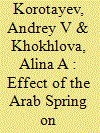| Srl | Item |
| 1 |
ID:
183687


|
|
|
|
|
| Summary/Abstract |
In the Middle East and North Africa (MENA) region after the Arab Spring, monarchy has turned out to be a far stronger negative predictor of destabilization than it was before 2011. For the MENA, the period after 2010 can be subdivided into three periods: a mass protests period (2011–2012), the period of explosive growth of radical Islamist activities (2013–2016), and the second mass protest period (since 2016). Our analysis demonstrates that monarchies’ stabilization capacity was preserved in 2011–2012 and grew substantially during 2013–2016, as MENA monarchies turned out to be more resilient in the face of the outbreak of radical Islamism in the region.
|
|
|
|
|
|
|
|
|
|
|
|
|
|
|
|
| 2 |
ID:
116668


|
|
|
|
|
| Publication |
2013.
|
| Summary/Abstract |
The article analyzes the specifics of urbanization dynamics in Egypt, which is noteworthy for a number of reasons. First, there was a shift from the logistic trend in the 1970s, and the share of urban population stopped growing. The UN data analysis shows that such a shift usually occurs against the background of very serious economic difficulties (and other problems associated with them). However, the urban population proportion stopped growing in Egypt when the country was experiencing a period of exceedingly rapid economic growth. We find labor migration of unprecedented scale to be the main reason which engendered this seemingly paradoxical situation. We further proceed to analyze the UN forecast on the dynamics of the Egyptian urban population proportion up to 2050, which implies a return to the logistic trend and rapid growth of the urban population share, which is fraught with socio-political instability risks. However, we present data proving that the logistic urbanization trajectory is not inevitable for Egypt, and the destabilization risks connected with the rapid increase of urban population share are largely irrelevant to Egypt in the forecasted period.
|
|
|
|
|
|
|
|
|
|
|
|
|
|
|
|